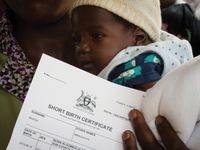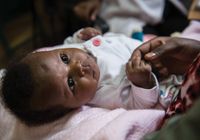
Photo credits: UNICEF/UGDA201300588/Sibiloni
5.5.1 Support for neonatal loss
Although much can be done to save the lives of newborns in humanitarian settings, some loss will occur. When a baby is stillborn or dies in the days and weeks after birth, respectful care and support for the mother and family are needed. In a crisis setting, professional counseling options for women will be limited, if not non-existent. Health workers should be trained and supported to provide culturally acceptable, appropriate support. Health professionals require skills to support parents and this includes knowing where and how to seek their own support and the ability to develop resilience to ensure the longevity of their career and to avoid burnout. Some tips for counseling mothers, fathers and families dealing with stillbirth and neonatal death:info
- Be empathic, factual and responsive. Answer parents’ questions, acknowledge when something is unknown or uncertain and undertake research to obtain information that parents may need. Give parents clear information in a sensitive and timely manner using understandable and non-technical language.
- If possible, ask if the mother and/or father want to hold their baby.
- Find out what the mother/family wishes to do with the baby’s body.
- Explain to the mother/family:
- The mother will need rest, support and good nutrition.
- The mother should not return to a full workload too early.
- The mother’s breasts will fill with milk in the early postpartum phase. In order to stop the production of milk, should that be the mother’s wish, additional support and counseling in line with local guidelines and best practices should be offered.
- Educate the mother and family about the normal changes in a woman’s hormones after pregnancy, which can make her feel sad, worried or irritable. Normally, postpartum women are extremely emotional, and may cry often. Given the baby’s death and the compounded stress of the crisis situation, these feelings of sadness may be intense.
- Ensure that the mother knows she did not cause the baby’s death. Provide information, when available, to the mother/family about the cause of the baby’s death.
- Encourage the mother to use a family planning method to postpone versus avoid a subsequent pregnancy and to resist having a ‘replacement’ child for the one that was lost.
- Link the mother to available SRHabbreviation care including family planning services.
- Link the mother to grief counselling services. Although specific services to support women facing the death of newborns may not be available, grief counselling for victims of humanitarian crises will likely be available in camp, temporary or mobile clinic and hospital settings.
5.5.2 Documenting neonatal loss
Documenting newborn loss is important to ensure that all neonatal deaths are captured and counted.
- Establish a clear system to document and report deaths at the community and facility levels (See Box 5.4).
- Ensure deaths are captured in a central register.
- Train health staff to register all newborn deaths, including stillborns. Information collected should include date of birth, date of death, place of death, weight at birth and cause of death.
- Provide a copy of the death certificateinfo to the mother or family, in accordance with national practice. In settings where newborn death certificates are not yet available, work with the local health facilities to provide a facility death certificate.
Box 5.4: Documenting Neonatal Deaths and Using Data to Improve Care
During humanitarian crises, many births and deaths occur outside of health facilities. As a result, standard health information systems may not provide accurate information on levels and trends in mortality. Furthermore, standard survey and data review processes may be compromised, and vital records may be lost or damaged at both community and national levels.
To compensate for these challenges, employ the following tactics:
- Track the number of neonatal deaths and stillbirths at health facilities and in the community/at the household level;
- Implement mortality audits, reviews, or confidential inquiries to gather and analyze information on where and why these deaths occurred;
- Engage health workers in review of de-identified findings from mortality audits to identify actions that can be taken to prevent future deaths;
- Monitor efforts to improve programs and health services. Where possible, share results with communities and the health workers serving them.
In some settings, these actions may be implemented as part of a Maternal and Perinatal Mortality Surveillance and Response (MPDSR) system described in WHO operational guidance. In other settings, processes for identifying, reporting, and reviewing deaths may need to be simplified.
- During the acute phase of a response, tracking deaths is crucial, and the focus should be on rapid surveillance, counting deaths, and establishing critical health services.
- Where there are no surveillance systems in place, or humanitarian access is limited, a phased approach may be needed – starting with review of deaths at larger, high-volume facilities and expanding to identification and review of deaths outside of facilities as feasible.
- In settings with high neonatal mortality and stillbirth rates, it may not be feasible to audit and review all deaths in detail. In this case even auditing a sample of perinatal deaths can provide valuable insights on areas for program improvement.
When conducting mortality surveillance and death reviews at any stage of a humanitarian response, collaboration among actors is a key component. Engagement of the health program management, host government and/or camp management, and communities in taking action to prevent future deaths is especially critical.

